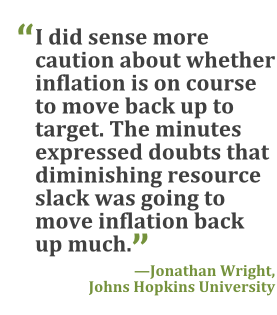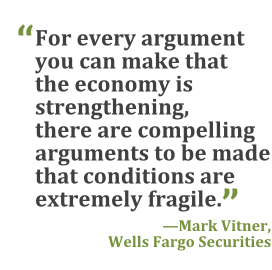Federal Reserve officials signaled concern about stubbornly lowinflation even as they indicated that an improving job market isbringing them closer to the first interest-rate increase in almosta decade.
|Participants in the July 28-29 Federal Open Market Committee(FOMC) meeting said economic conditions “were approaching thatpoint” where the economy could sustain a slight increase inborrowing costs, according to minutes of the meeting released inWashington on Wednesday.
|Preserving their flexibility on the timing of rate liftoff, theyalso showed more concern about how soon they would hit their 2percent inflation target, a goal they have missed for more thanthree years.
| Theirdebate was silent on whether they should act in September or delayto await more evidence that inflation is heading higher. Thatdiscussion highlights a dilemma for the data-dependent FOMC: As thejob market continues to deliver robust gains, with unemployment at5.3 percent, holding interest rates near zero is harder to justifyas the expansion enters its seventh year.
Theirdebate was silent on whether they should act in September or delayto await more evidence that inflation is heading higher. Thatdiscussion highlights a dilemma for the data-dependent FOMC: As thejob market continues to deliver robust gains, with unemployment at5.3 percent, holding interest rates near zero is harder to justifyas the expansion enters its seventh year.
At the same time, officials want to avoid the error oftightening policy too soon, especially when inflation gauges remainpersistently weak.
|“I did sense more caution about whether inflation is on courseto move back up to target,” said Jonathan Wright, a professor atJohns Hopkins University in Baltimore and a former economist at theFed's Division of Monetary Affairs. “The minutes expressed doubtsthat diminishing resource slack was going to move inflation back upmuch.”
|The committee's hand-wringing over its inflation goal wasinterpreted by investors as a lack of conviction they would beready to raise rates at the Sept. 16-17 FOMC meeting. Theprobability of a September rate increase fell to 36 percent,according to prices in the federal funds futures markets, from 50percent earlier on Wednesday.
|Wright said the committee gave “no strong signal” on Septemberand in his view it was “a coin-toss between September or December.”The FOMC's October meeting will not be followed by a pressconference. Fed Chair Janet Yellen says every meeting is “live” fora rate decision, though most economists say she would rather act ata meeting after which she could immediately speak withreporters.
|During their discussion, officials last month “noted thatconsiderable uncertainty remained” about when wages would rise and“whether that development might translate into increased priceinflation.”
|Chinese Economic Slowdown Create Risks
|Global commodity prices have slumped, due in part to a Chineseslowdown, and this could maintain downward pressure on inflation,while U.S. wage increases have been stuck in a narrow range ofabout 2 percent annually since the recovery began in June 2009.
|Several officials warned at last month's meeting that slowerChinese growth may pose risks to the U.S. economic outlook.
|The International Monetary Fund in Julynotched down its forecast for global growth this year to 3.3percent, after saying in June that the Fed should delay liftoffuntil the first half of 2016.
|“For every argument you can make that the economy isstrengthening, there are compelling arguments to be made thatconditions are extremely fragile,” said Mark Vitner, senioreconomist at Wells Fargo Securities in Charlotte, NorthCarolina.
| Theminutes said “many” officials “continued to see some downside risksarising from economic and financial developments abroad” though therisks to the domestic outlook were “nearly balanced.”
Theminutes said “many” officials “continued to see some downside risksarising from economic and financial developments abroad” though therisks to the domestic outlook were “nearly balanced.”
The labor market has shown continued progress since the FOMCmeeting, with U.S. employers adding 215,000 jobs in July comparedwith the year-to-date monthly average of 211,000.
|While “most members” of the FOMC saw room to let labor marketslack diminish further, “several” viewed current conditions “as ator very close to those consistent with maximum employment.”
|Data-dependence under Chair Yellen means that the committee canshift its emphasis from labor markets, to inflation, to globaleconomic stability as it seeks the right conditions to raise rates,said Matthew Whitbread, an investment manager at Baring AssetManagement in Boston.
|While the committee raised more concerns about inflation, theminutes also reflected the intent to raise rates as soon aspossible, he said.
|“The discussion revolves around policy normalization,” he said,and in his view that begins in September with a quarter-point ratehike. “Nothing in these minutes would lead me to believe that thiswould not be the case.”
|–With assistance from Matthew Boesler in New York.
|Copyright 2018 Bloomberg. All rightsreserved. This material may not be published, broadcast, rewritten,or redistributed.
Complete your profile to continue reading and get FREE access to Treasury & Risk, part of your ALM digital membership.
Your access to unlimited Treasury & Risk content isn’t changing.
Once you are an ALM digital member, you’ll receive:
- Critical Treasury & Risk information including in-depth analysis of treasury and finance best practices, case studies with corporate innovators, informative newsletters, educational webcasts and videos, and resources from industry leaders.
- Exclusive discounts on ALM and Treasury & Risk events.
- Access to other award-winning ALM websites including PropertyCasualty360.com and Law.com.
*May exclude premium content
Already have an account? Sign In
© 2024 ALM Global, LLC, All Rights Reserved. Request academic re-use from www.copyright.com. All other uses, submit a request to [email protected]. For more information visit Asset & Logo Licensing.







